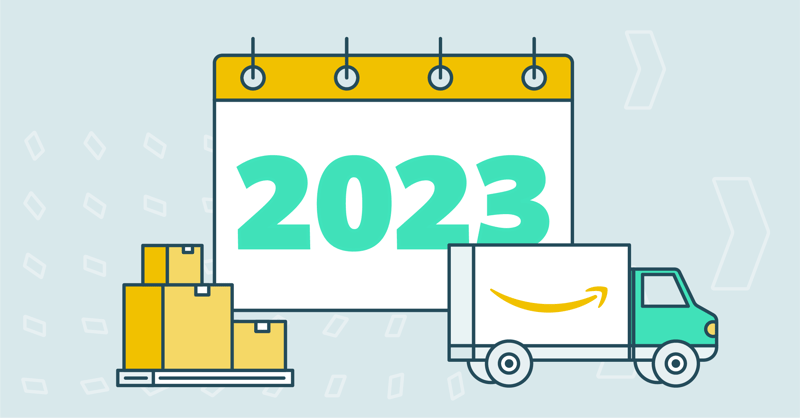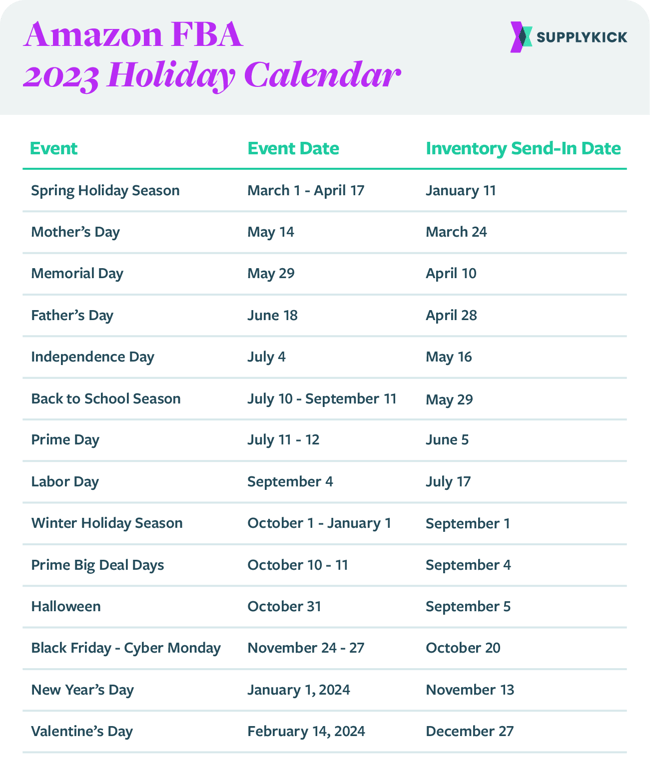Last updated: September 18, 2023
Supply chain challenges and product stockouts, recession and inflation-induced shifts in consumer spend: the past few years have been a wild ride for FBA sellers. To rise above the changes and unpredictabilities brands continue to face in the ecommerce space, it’s important to keep your eye on the prize with an effective inventory forecasting plan in place—one that ensures you have enough product available during Amazon's peak shopping seasons and proactively reduces surpluses and stockouts throughout the year.

Supply chain challenges and product stockouts, recession and inflation-induced shifts in consumer spend: the past few years have been a wild ride for FBA sellers. To rise above the changes and unpredictabilities brands continue to face in the ecommerce space, it’s important to keep your eye on the prize with an effective inventory forecasting plan in place—one that ensures you have enough product available during Amazon's peak shopping seasons and proactively reduces surpluses and stockouts throughout the year.
As you prepare your marketplace strategy for 2023, a key question to ask is: “When should I send in my FBA inventory to ensure it’s received on time?” To make things easier on you, our logistics team created this calendar outlining the most important dates to know and when to send your product inventory to Amazon Fulfillment Centers (FCs).
This should help keep your stock levels on track, but be sure to anticipate and accommodate seasonality or specific trends related to your brand, customers, and product assortment, too:

| • | Spring Holiday Season (Spring Break, St. Patrick's Day, Easter, etc): March 1 - April 17 | Inventory Send-In Date: January 11 |
| • | Mother’s Day: May 14 | Inventory Send-In Date: March 24 |
| • | Memorial Day: May 29 | Inventory Send-In Date: April 10 |
| • | Father’s Day: June 18 | Inventory Send-In Date: April 28 |
| • | Independence Day: July 4 | Inventory Send-In Date: May 16 |
| • | Back to School Season: July 10 - September 11 | Inventory Send-In Date: May 29 |
| • | Prime Day: July 11 - 12 | Inventory Send-In Date: June 5 |
| • | Labor Day: September 4 | Inventory Send-In Date: July 17 |
| • | Winter Holiday Shopping Season: October 1 - January 1 | Inventory Send-In Date: September 1 |
| • | Prime Big Deal Days: October 10-11 | Inventory Send-In Date: September 4 |
| • | Halloween: October 31 | Inventory Send-In Date: September 5 |
| • | Black Friday - Cyber Monday: November 24 - 27 | Inventory Send-In Date: October 20 |
| • | New Year's Day: January 1, 2024 | Inventory Send-In Date: November 13 |
| • | Valentine’s Day: February 14, 2024 | Inventory Send-In Date: December 27 |
The biggest question on many brands' and Amazon Prime sellers' minds is when is Amazon Prime Day 2023—and will the retailer host a fall Fall Prime Day/Prime Early Access Sale? In addition to maintaining the standard mid-summer Prime Day, Amazon has confirmed plans to host a second Prime event this fall, propelling summer and winter peak shopping seasons.
Amazon is notorious for announcing official dates just weeks before the big sales events—keeping brands, retailers, and other ecommerce marketplace competitors (Target, Walmart, Home Depot, Lowe's) on their toes and with little prep time. We suggest closely monitoring Coupon submission deadlines and their FBA inventory cut-off dates to help clue you in on Amazon Prime event dates.
Prime Big Deal DaysLast year, Amazon rang in the Q4 2022 holiday shopping season by delighting consumers (and surprising sellers) with a Fall Prime Day/Prime Early Access Sale. This year, the retailer is following suit with a second Prime event this fall. Amazon's Prime Big Deal Days event will take place on October 10-11, 2023.
Since Prime Big Deal Days will be the start of Q4 shopping, we recommend fine-tuning your Prime strategy early. Review data and consumer insights from this summer's Prime Day and last year's holiday sales. Adjust your plans accordingly, with an emphasis on inventory forecasting, keyword research, listing optimization, and advertising performance. Keep in mind that many people aren't just shopping for others, they're "gifting" themselves as well, so it's crucial to take advantage of the surge in traffic during this high-spend season.
Think of the most recent Prime Day as a crash course as you prepare for the next one: What worked, what didn’t, and what could you have done better? Did your customers behave the way you expected them to? Do you need to make some strategic changes (stock, product assortment, shipping methods, marketing/branding)? Make those changes now and focus on these 8 strategies to maximize Prime Big Deal Days sales potential.
Prime Day 2023Prime Day 2022 was Amazon's biggest Prime Day to date, with over 300 million items purchased worldwide and close to $12B generated during the 48-hour event. Amazon announced that this year's Prime Day will be on July 11-12, 2023, which is just one day earlier than the previous year. The 48-hour event takes place for Prime members in the U.S., Canada, Mexico, U.K., and more.
Amazon officially announced this news on June 21, 2023, a little under a month before the big event, though they dropped subtle hints leading up to the date with shipping and Prime Day deal deadlines. Last year, Amazon announced Prime Day 2022 just three weeks before the big event, sending brands scrambling to shift plans ahead of schedule. Be sure to check out this Prime Day 2023 seller guide for strategies to quickly pivot and capitalize on increased platform traffic and Prime Exclusive Discounts.
As we continue to rebuild from the previous pandemic economy, retailers have learned to expect fluctuations with Amazon fulfillment and ever-changing consumer shopping habits. While some industries have started to recover to predictable production and ship times, we expect supply chain and production bottlenecks and worker shortages to continue, leading to delays in fulfillment and risking inventory stockout. Be sure to stay alert, flexible, and adapt your inventory forecasting strategy accordingly.
When it comes to FBA inventory receiving and processing times, shipment types, shipment origins, quantities, and the number of Amazon FCs receiving your inventory all come into play. For example, we’ve found that Parcel shipping usually takes an average of one week to deliver and receive, while Less-Than-Truckload (LTL) shipments take quite a bit longer—about two to three weeks to deliver and receive, sometimes longer depending on the fulfillment center’s capacity.
If you’re experiencing issues with FBA storage limits and stockouts, Amazon launched AWD (Amazon Warehousing & Distribution) as a 3PL and bulk storage solution for sellers. The solution allows FBA sellers to avoid stockouts and auto-replenish inventory into Amazon FCs.
As you plan your Amazon inventory line up for 2023, take a look at how seasonality impacts your customers’ behavior—and remember that Amazon category sales can fluctuate based on the season as well as the evolving macroeconomic environment.
Spring often spurs sales increases in Sports & Outdoor, Luggage & Travel Gear, Tools & Home Improvement, and Patio, Lawn & Garden products as shoppers get ready for spring break vacations or prep their yard for warm-weather activities. On the other hand, categories like Toys & Games, Handmade, and Sports & Fitness shine during the winter months as consumers purchase holiday gifts and prep for their New Year’s resolutions. Be sure your inventory forecast accounts for any seasonal shifts to avoid the risk of stockouts or accumulating aging inventory.
Speaking of top-selling seasons, consumers seem to start their holiday shopping earlier each year—and we expect that trend to continue, with the holiday shopping season kicking off well before Black Friday and even Halloween, as early as October 1. Keep in mind that almost half of Amazon consumers say they shop for themselves during the holidays—so even if you don’t offer giftable items, be sure to take advantage of increased platform traffic and consumer spend throughout Q4. Track customer behavior and big box retailer promotions, and plan your inventory send-in, competitive pricing and coupon strategies, packaging inserts, and Amazon Ads budget accordingly. Find more logistics, advertising, and marketing tips to increase Amazon sales in Q4 here.
Whether it’s the winter holiday season or your brand’s busy season, success on Amazon means building a holistic, well-thought out logistics, pricing, marketing, advertising, and customer service strategy. Use this checklist to stay on track, implement best practices, and set yourself up for success ahead of time.
 |
|||||||||||||||||||||||||||||||||||||||||||||||||

|

|
||||||||||||||||||||||||||||||||||||||||||||||||

|

|
||||||||||||||||||||||||||||||||||||||||||||||||
Whether you’re currently selling FBA or looking to switch from Vendor to Seller Central, SupplyKick can help create an optimal inventory strategy for your brand—either as a trusted third-party seller of your products, or as an Amazon agency consultant serving as an extension of your team. With hundreds of partners and over a decade of marketplace experience, SupplyKick specializes in working with brands who want to achieve more but don’t have the time, expertise or resources necessary to excel on today’s leading marketplaces.
Our inventory forecasting analysts help you navigate any supply chain challenges you’re currently facing and track trends to keep up with demand and reduce stockouts. Selling on Amazon can get complicated, but it doesn’t have to be. Connect with our team.
Lorem ipsum dolor sit amet, consectetur adipiscing elit


Sign up to receive our newsletter for growth strategies, important updates, inventory and policy changes, and best practices.
These Stories on Logistics & Fulfillment
For press inquiries, please contact Molly Horstmann, mhorstmann@supplykick.com